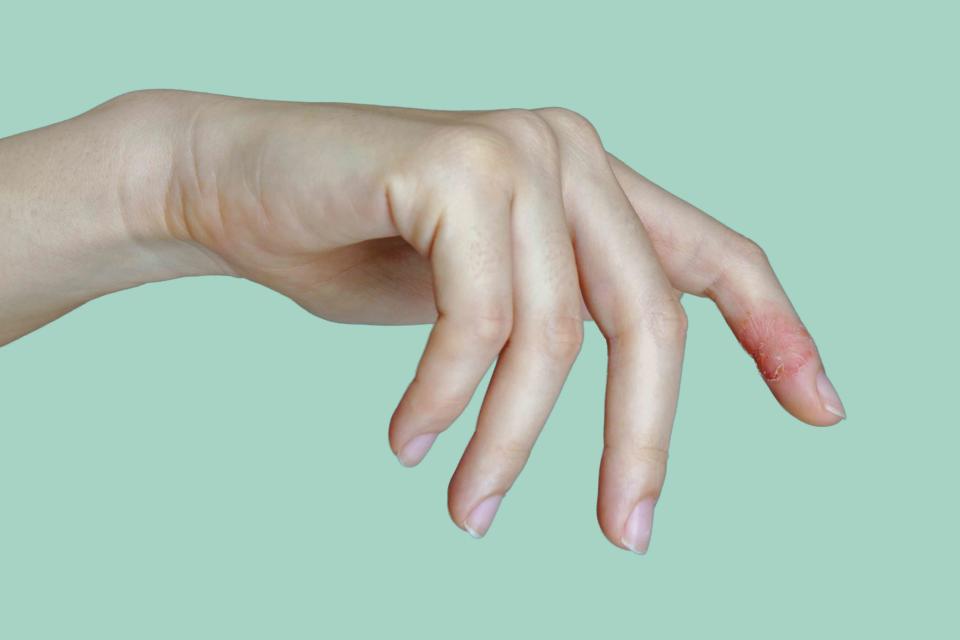The Different Stages of Atopic Dermatitis—and How to Treat Each
Did you know there are three distinct stages of atopic dermatitis? Proper management of each is the key to relief.

Triocean/Getty Images
Atopic dermatitis, a common form of eczema, is an inflammatory skin condition that impacts millions of people across the United States and beyond. In other words, if you or someone you know experiences the dry, scaly, and blister-y patches associated with this chronic condition, you’re among many.
“Eczema flare-ups can be caused by an overactive immune system, environmental factors, and even emotional stress,” notes Jeremy Brauer, MD, FAAD, a board-certified dermatologist at New York City’s Spectrum Skin and Laser. “This condition also looks different for everyone and can vary greatly based on your skincare routine.”
Managing this form of eczema is important in order to prevent discomfort, pain, and worsening of the condition. Keep reading to learn about the three distinct stages of atopic dermatitis and expert insight for treatment.
The Three Stages of Atopic Dermatitis
There are three distinct stages for atopic dermatitis. We’re covering each below and offering the best treatment approach for each.
Acute Atopic Dermatitis
Acute atopic dermatitis describes both the initial onset of this condition and the first phase of a flare up for those who’ve already been diagnosed. Though you’d assume the first stage is mild, that’s not necessarily true since there’s so much inflammation triggering the flareup to begin with.
Looks Like: Dr. Brauer says, “Acute atopic dermatitis may be characterized by vesicular, crusting, blistering, and oozing skin.” You might also experience small red bumps, redness, burning, itchiness, and ongoing irritation.
Best Treatment: First, identify any potential trigger for the flare up and remove it. From there, you can begin treatment.“The mainstay of treatment for this is topical anti-inflammatory medications including steroidal and nonsteroidal options,” says Aya Ahram, DO, FAAD, a board-certified dermatologist at Hudson Dermatology & Laser Surgery.
You can use over-the-counter hydrocortisone or antihistamine products, which help reduce your body’s overactive immune response. (If you’re unsure what to choose, your doctor can prescribe products or help you choose the best potency.)
A gentle, hydrating skincare regimen using products intended for sensitive and eczema-prone skin is also recommended. Cold compresses (versus itching or rubbing) can help soothe the irritation. If a rash becomes infected, you’ll need a prescription for antibiotics.
Subacute Atopic Dermatitis
Also known as the “healing” phase of atopic dermatitis, this second stage is often much less severe from the first. In some cases, your eczema may actually start in this stage (remaining more mild in nature) or oscillate between acute and subacute.
Looks Like: “Subacute atopic dermatitis is similar to acute dermatitis, but symptoms are often less intense,” Dr. Bauer says. “This phase is characterized by dryness, scaling, and crusting skin.” You might also still experience some irritation or itchiness, dry and cracked skin, flakiness, and persistent redness. The intense oozing, blistering, and pain isn’t associated with this stage.
Best Treatment: It’s important to steer clear of any potential trigger that may cause your eczema to go back into the acute phase or prevent patches from healing. From here, you can continue the anti-inflammatory regimen recommended by your doctor.
As you move deeper into the healing phase, keep following that supremely gentle and deeply moisturizing skincare routine, using thick ointments on “hot spots” that need more attention. Also be on the lookout for potential infections so you can treat them immediately, and use cool compresses to soothe your skin.
Antihistamines that reduce itching and inflammation can also keep you from scratching this healing skin.
Chronic Atopic Dermatitis
True to its name, chronic atopic dermatitis is characterized by longer lasting flares or symptoms. You don’t reach this stage until you’ve dealt with the symptoms for three or more months. In addition to the ongoing nature of the symptoms, there are also some key physical traits associated with this stage of eczema.
Looks Like: Chronic atopic dermatitis presents with what’s called “lichenified” skin, or thick, dry patches that have a leathery appearance. You might also experience darkened areas (hyperpigmentation), deep cracks, and itching. “Over time, if these lesions are chronically scratched, it can develop into nodule-like lesions,” says Dr. Ahram.
Best Treatment: The best treatment for chronic atopic dermatitis also includes topical steroids and nonsteroidals, typically at stronger concentrations, Dr. Ahram says. “However there are also other modalities for more extensive disease such as injectable biologics, [some of which are] approved down to six months of age and can be truly life changing,” she adds.
You’ll also want to continue that soothing skincare regimen that leverages deeply moisturizing creams and ointments, cool compresses and antihistamines to soothe the itch, and avoid all potential triggers. Seeing a professional can help with management if you feel like you can’t get ahead of the flare ups or discomfort.
For more Real Simple news, make sure to sign up for our newsletter!
Read the original article on Real Simple.

